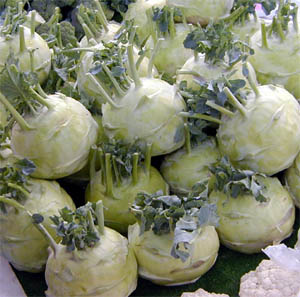
Kohlrabi, Brassica olearcea var. gongylodes, is a hardy biennial member of the cabbage family. It was first recorded being grown in northern Europe in 1554, and had reached North America at least by the early 1800’s. The name is a German word meaning cabbage (kohl) – turnip (rabi), describing the turnip-like enlargement of the stem above the soil (it is not a root vegetable). Leaves stand out like spokes from the edible portion, the rounded stem section, which is commonly referred to as a bulb (even though botanically it is not a bulb). Although it is quite exotic looking, it is merely a different horticultural form of the same species to which common cabbage, kale, broccoli, and cauliflower belong. Its flavor is similar to that of turnips but milder and sweeter.
Varieties
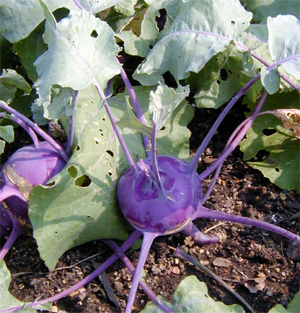
There are a number of both “white” (really light green) and purple cultivars. The purple types only have colored skin; the interior flesh is white. In Europe, fancy varieties with frilled and deeply cut leaves are sometimes grown as ornamentals. The number of days from planting to harvest is indicated after each.
- ‘Early White Vienna’ is a standard white variety with few leaves (55 days).
- ‘Early White Purple’ is a standard purple variety with flattish, red-purple (60 days).
- ‘Eder’ is a tender and fast-maturing white type (38 days).
- ‘Express Forcer’ is a white type with compact plants that hold up well even in heat (42 days).
- ‘Gigante’ is best for fall crops, producing an extremely large bulb up to a foot in diameter and 25 pounds, that does not get woody (80 days).
- ‘Grand Duke’ produces vigorous small plants that are tolerant of black rot (45 days).
- ‘Granlibakken’ offers excellent texture and sweet, mild flavor (45 days).
- ‘Kolibri’ is a new deep purple Dutch hybrid that produces large bulbs (up to a pound) with nearly fiberless white flesh (43 days).
- ‘Kossak’ is another very large variety, producing bulbs up 10 inches across with sweet, delicate flavor (70 days).
- ‘Logo’ is a super-early white forcing type used in Europe for baby vegetable production (45 days).
Culture

Kohlrabi is easy to grow in full sun in moist, well-drained soil rich in organic matter. Like other cole crops, they do best in cool weather but tolerate heat better than most other members of the cabbage family. Sow seeds directly in the ground in early spring as soon as the soil is workable. For an earlier harvest, seeds can be started indoors 4-6 weeks before transplanting outdoors when the ground is ready. For a continuous supply through late spring and early summer, make small plantings every 2-3 weeks. Fall plantings should be sown in mid-summer. Plants are cold-tolerant and will survive in the garden long after frost. Plan your planting so harvest will be a week or two after the first fall frost is expected in your area.
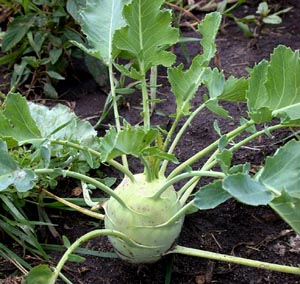
Place seeds ¼-½” deep and thin the seedlings to 2-5″ apart (or more if you are growing one of the huge varieties). Keep the plants well-watered, as abundant moisture will prevent the stems from becoming tough and woody. Cultivate carefully to avoid damaging the shallow roots. Fertilize before planting and again at midseason.
Pest Management
Kohlrabi generally has few insect or disease problems. Cabbage caterpillars (imported cabbageworm, cabbage looper and diamondback moth) may infest the plant, but their feeding on the leaves doesn’t affect yield unless populations are very high. These caterpillars can be controlled by hand-picking, chemical sprays, or applications of Bacillus thuringiensis (Bt). Yellows, clubroot, black rot and downy mildew are a few cabbage family diseases that may affect kohlrabi but are not common in the home garden. Plant disease resistant varieties when available and maintain vigorous plants. Avoid handling the plants when they are wet and remove any infected plants/plant parts.
Harvest
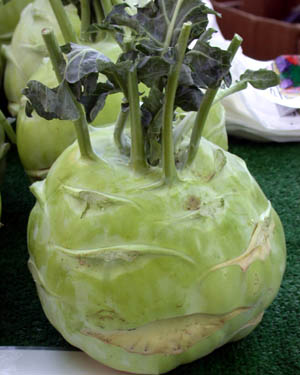
Kohlrabi has the mildest and best flavor when small. Older kohlrabi tends to be tough and woody and it may have an off-flavor – except in some newer varieties, such as ‘Gigante’ and ‘Kossak’ that do not develop woody fibers in the enlarged stem. You can begin harvest when the bulbs are about one inch in diameter and continue harvesting until the bulbs reach the mature size for that variety. Pull the entire plant out of the ground, or cut it off at ground level.
To store kohlrabi for several weeks, remove the leaf stems and place, unwashed, in sealed plastic bags in the refrigerator.
– Susan Mahr, University of Wisconsin – Madison





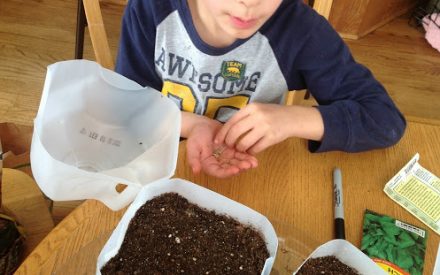 Seed Starting
Seed Starting Growing Vegetables at Home: Questions and Answers
Growing Vegetables at Home: Questions and Answers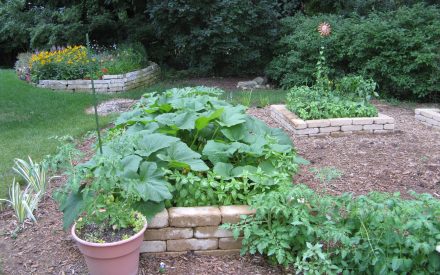 Growing Vegetables in Containers
Growing Vegetables in Containers Homegrown Tomatoes for Wisconsin
Homegrown Tomatoes for Wisconsin


